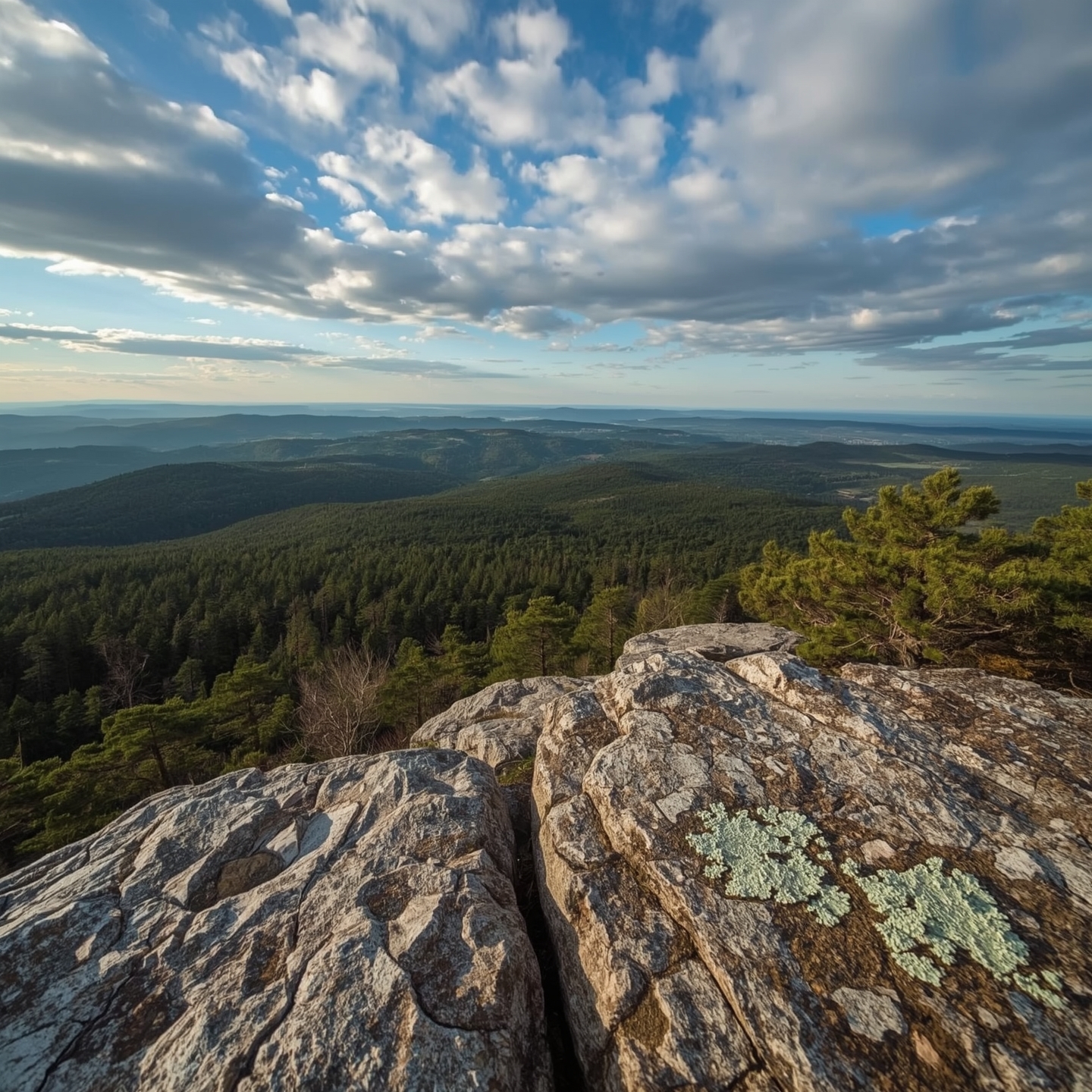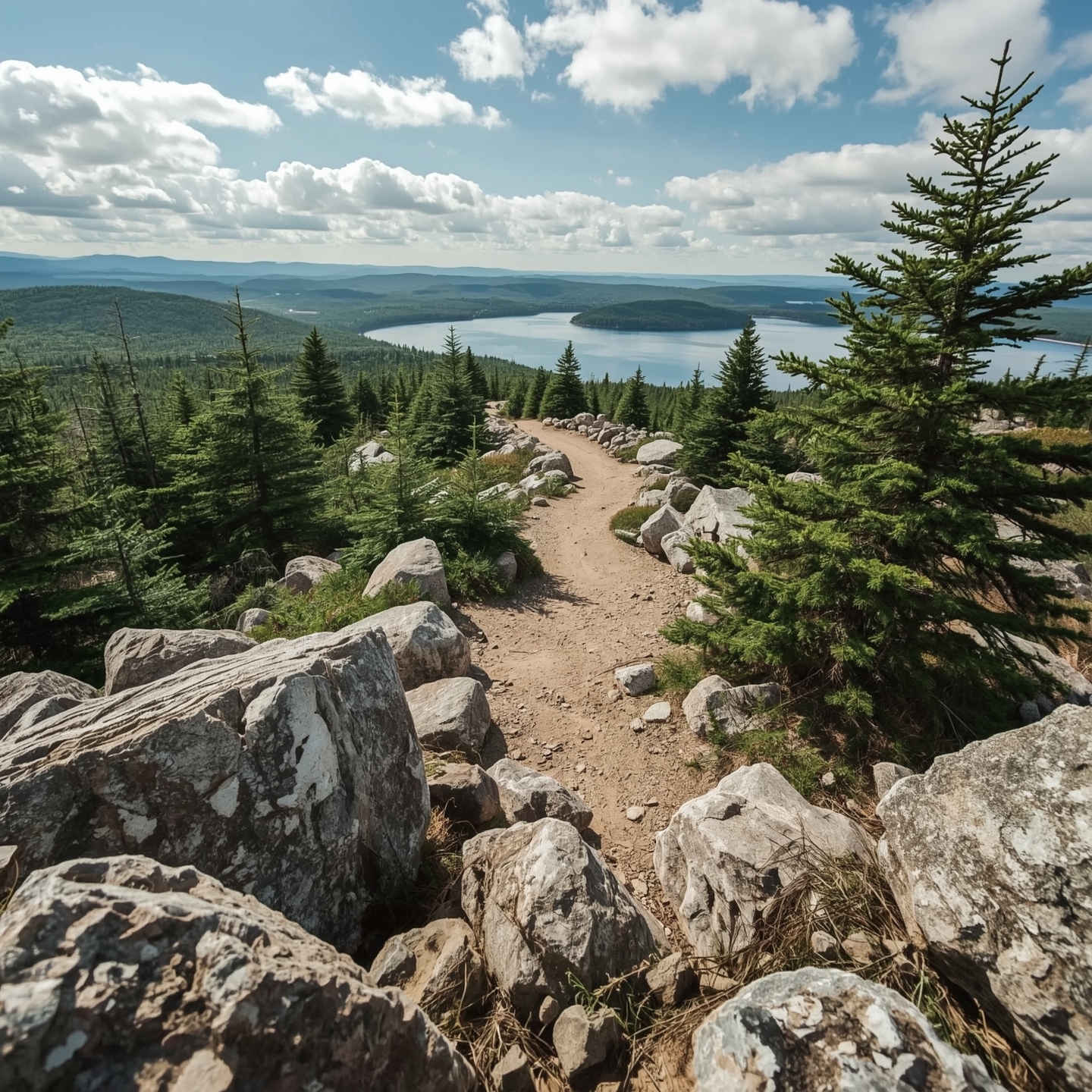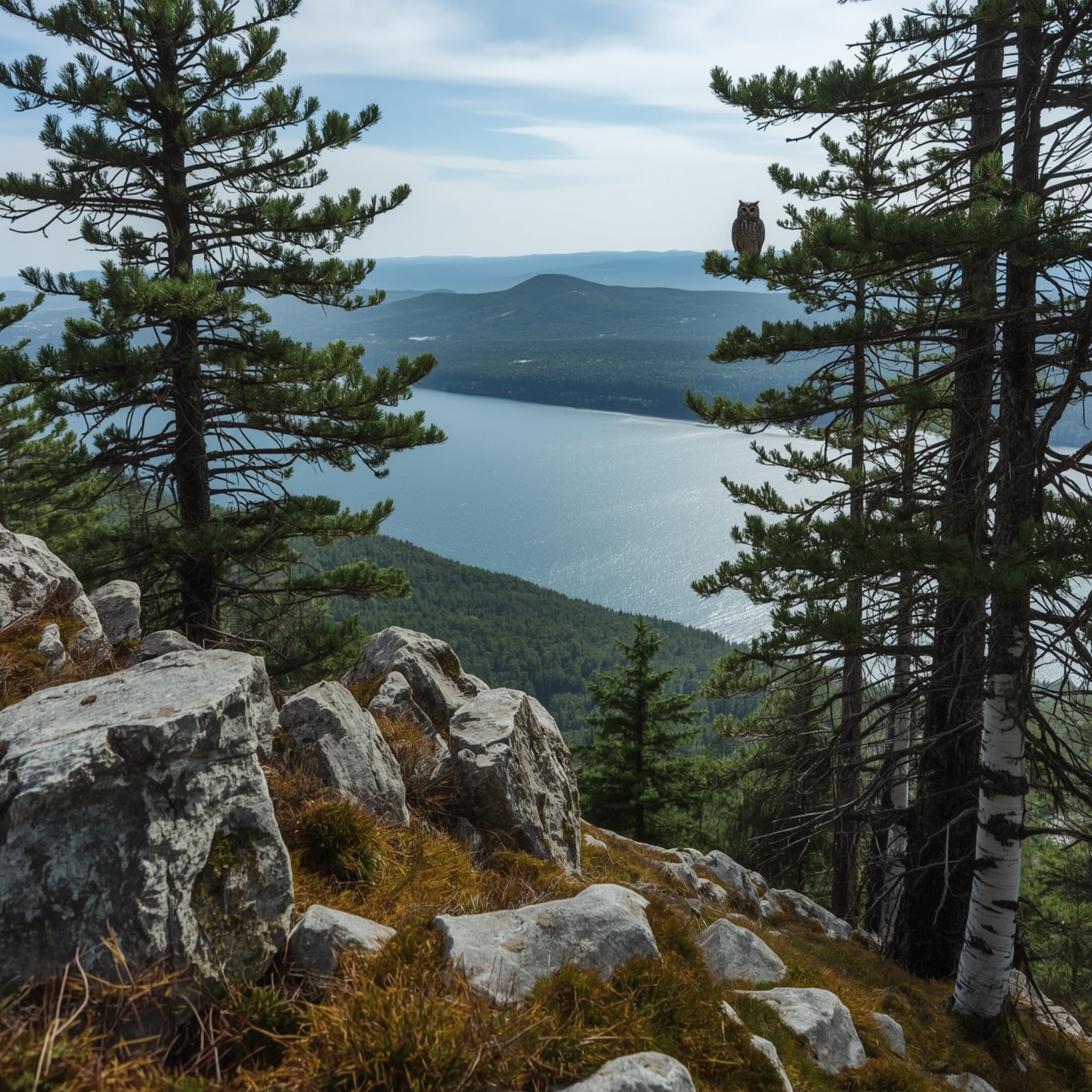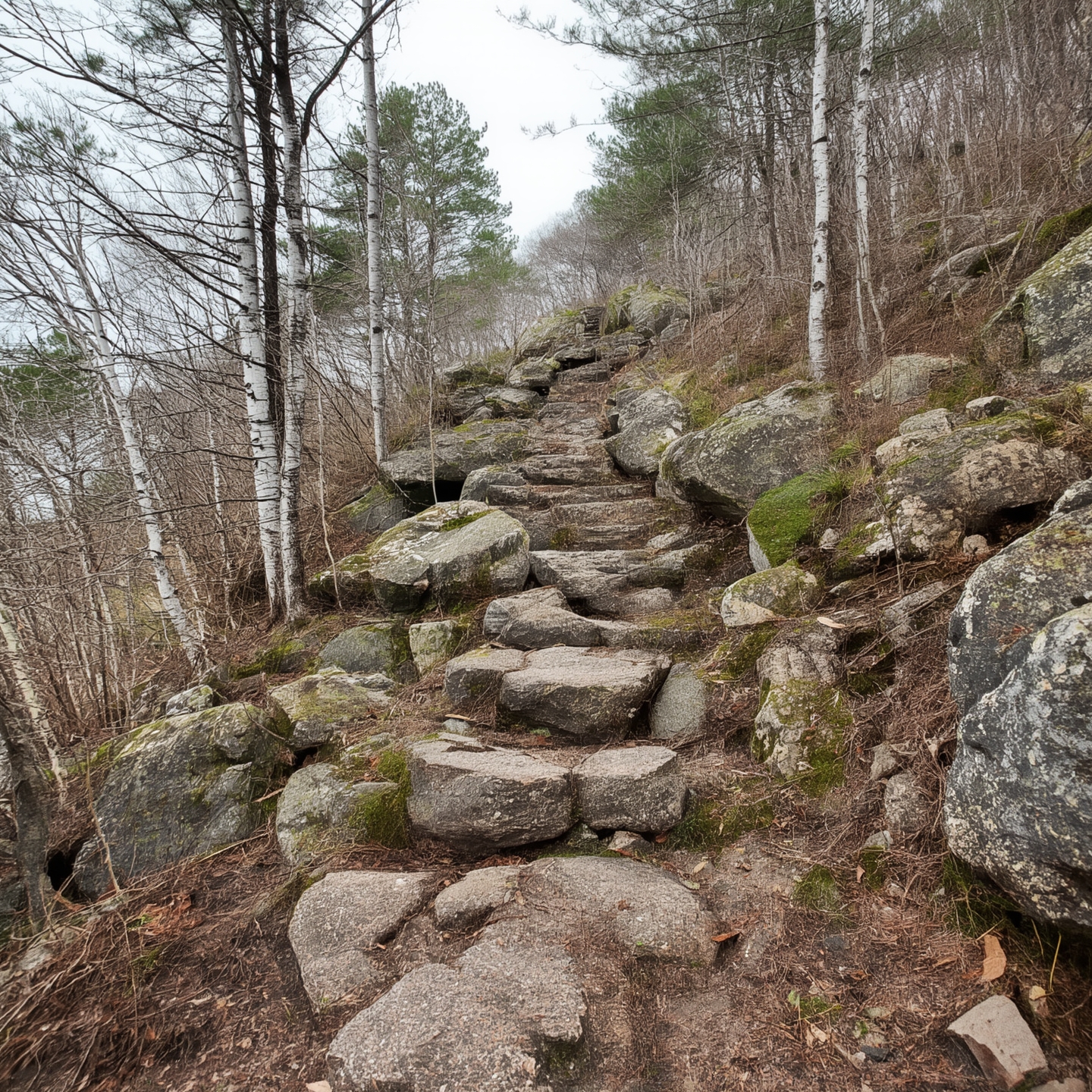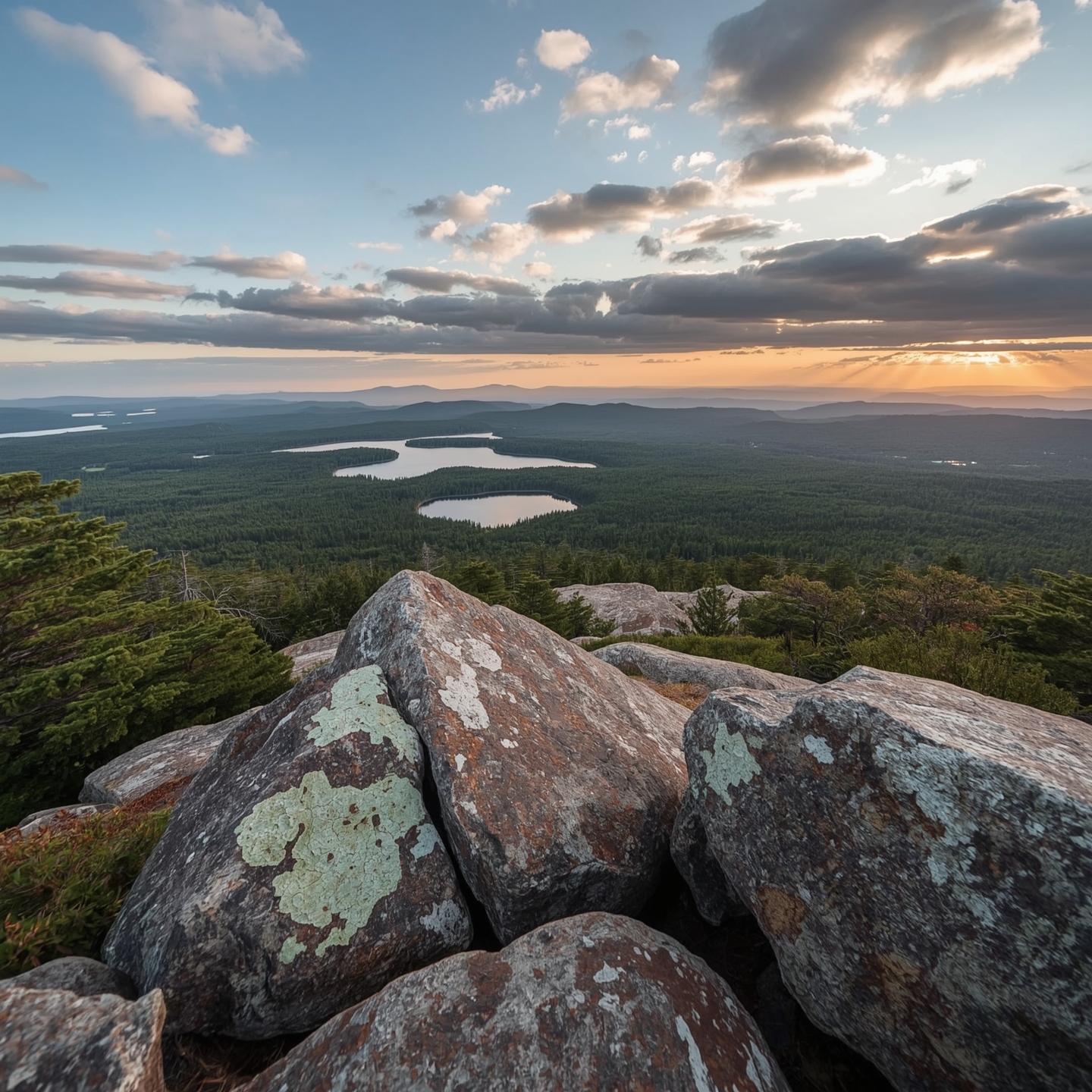Huguenot Head Acadia National Park
Discover Huguenot Head Acadia
Huguenot Head Acadia is one of those places in Acadia National Park that hikers often stumble upon by surprise. It doesn’t have the height or fame of Cadillac or Champlain, yet this modest rise on Mount Desert Island delivers a quiet charm all its own. For many visitors, it feels like a secret — a chance to step into Acadia’s rugged landscape without the rush of the more crowded trails.
The setting here is unmistakably Acadian. Granite ledges streaked with lichen, spruce and fir rising in clusters, and the ever-present scent of pine make the approach feel authentic and unspoiled. From its open clearings, you can sense the connection to the greater landscape: the forest stretching toward the sea, the nearby ridgelines, and the vast sweep of sky above. It’s not about altitude but about atmosphere — a reminder that even the smaller peaks in this park hold character and beauty worth exploring.
For those who enjoy walking in nature without pressure, Huguenot Head Acadia offers just that. It’s approachable, scenic, and welcoming to anyone with an hour or two to spare. Some treat it as a brief outing, while others weave it into larger hikes, but either way it becomes a highlight. Simple and understated, Huguenot Head proves that in Acadia, you don’t always have to climb the highest mountains to experience something memorable.
🌲 Huguenot Head at a Glance
- Huguenot Head Acadia is one of the park’s quieter summits.
- Known for granite ledges, moss, and forested surroundings.
- A shorter option compared to nearby Champlain Mountain.
- Ideal for visitors seeking a peaceful, less-crowded hike.
Hiking Trails to Huguenot Head
The primary way to reach Huguenot Head iAcadia s by following the Beachcroft Path, one of Acadia’s classic stone stairway trails. Built in the early 1900s by the Civilian Conservation Corps and park stewards who valued natural craftsmanship, the path is a marvel of careful design. Hundreds of flat granite steps guide hikers steadily upward, blending so well with the terrain that it feels as though the trail has always been part of the mountain. For many visitors, the Beachcroft Path itself is as memorable as the destination.
From the trailhead along Route 3, the path begins almost immediately with stonework, winding through spruce and fir. The grade is steady rather than steep, which makes it approachable for families and less experienced hikers. After a short ascent — usually less than an hour depending on pace — you arrive at the open granite ledges of Huguenot Head. The ledges here feel surprisingly expansive for such a modest summit, offering a taste of Acadia’s famous granite landscapes without the demands of a longer or tougher climb.
For some, Huguenot Head marks the turning point: a short, rewarding hike that offers fresh air, views, and the satisfaction of “climbing a mountain” in Acadia. For others, it serves as a scenic checkpoint on the way to Champlain Mountain, which rises directly behind it. Continuing on adds both distance and effort, but it also creates one of the park’s most enjoyable two-stage hikes: the quiet ledges of Huguenot Head followed by the sweeping vistas from Champlain’s higher ridges.
The trail conditions are typical of Acadia: rocky, uneven in places, and often lined with roots. Good footwear is recommended, especially if the granite is damp, as lichen and moss can create slick patches. Despite these challenges, most hikers find the climb comfortable, particularly when compared to the more demanding scrambles of Beehive or Precipice. Children often enjoy the “step-like” design of the trail, and adults appreciate that the effort is rewarded quickly with views.
In total, the hike to Huguenot Head Acadia and back is a compact outing that rarely exceeds two miles. It’s an ideal choice for visitors looking for a manageable but scenic walk, a warm-up for bigger Acadia adventures, or simply a quieter trail that still delivers that essential combination of granite, forest, and sky.
🌲 Trail Notes: Hiking Huguenot Head
- Main Route: Beachcroft Path from Route 3.
- Distance: About 2 miles round trip (varies with extensions).
- Time: 45–60 minutes to summit, longer if combined with Champlain.
- Difficulty: Moderate — stone steps, rocky footing, manageable grades.
- Best for: Families, casual hikers, anyone seeking a short scenic climb.
- Highlights: Historic stonework, granite ledges, early summit views.
Views from the Summit
Standing on the granite ledges of Huguenot Head Acadia, you quickly realize that size isn’t everything in Acadia National Park. Though this summit rises modestly compared to Cadillac or Sargent, its position along the eastern ridgeline rewards hikers with views that feel expansive and immediate. The first impression is the openness: the trees thin out just before the summit, giving way to wide stretches of lichen-dappled rock. On a clear day, the light plays beautifully across these stone slabs, making them shimmer against the deep green of the surrounding forest.
Looking outward, you’ll catch glimpses of Frenchman Bay, where the ocean sparkles beyond Bar Harbor and the Porcupine Islands. The water acts as a dramatic backdrop to the island’s ridges, shifting in color from bright blue under midday sun to softer tones at dawn or dusk. To the west, the layered hills of Mount Desert Island unfold in a quilt of forest, broken by flashes of granite cliffs. Somes Sound, the fjord-like inlet that cuts deep into the island, sometimes peeks through the trees, adding an unexpected maritime touch to the inland views.
One of the charms of Huguenot Head is how its scenery changes with the seasons. In autumn, the ridges glow with fiery reds and golds, making the views from the ledges unforgettable. Spring brings bright greens and wildflowers along the path, while summer blankets the horizon in deep, steady hues of pine and spruce. Even winter has its appeal, when crisp air sharpens the visibility and the bare trees open more distant vistas.
What sets Huguenot Head apart is its atmosphere. Cadillac’s summit can feel crowded; Champlain’s exposed ridges can feel dramatic. Here, the views are gentler, quieter, and often shared with only a few other hikers. You might sit on the granite in near silence, with nothing but the wind and the distant call of birds. For photographers, painters, or anyone seeking a moment of calm, these ledges are a reminder that Acadia’s beauty is found not just in its grandest peaks but in its understated corners too.
🌅 Summit Views: Quick Facts
- Outlook: Frenchman Bay, Bar Harbor, Porcupine Islands.
- Seasonal Appeal: Autumn foliage, spring greens, crisp winter clarity.
- Character: Quiet, open granite ledges with lichen and moss.
- Photography: Best light in early morning and golden hour.
- Atmosphere: Calmer and less crowded than larger peaks.
Nature & Wildlife Around Huguenot Head
Huguenot Head Acadia may be modest in height, but it reflects the ecological richness that makes Acadia so unique. The climb begins in the shadow of a spruce–fir forest, where the air feels cool and shaded even in summer. Spruce, balsam fir, and hemlock form a thick canopy, while the understory is carpeted with ferns, mosses, and wildflowers that thrive in the damp, shaded ground. In spring and early summer, the forest floor brightens with trillium, bunchberry, and violets, lending pops of color to the otherwise deep greens.
As you approach the summit, the forest begins to thin and give way to Acadia’s signature granite ledges. Here, hardy plants adapted to shallow soil and harsh winds take hold. Patches of reindeer lichen and moss paint the rocks in silver, green, and rust-colored tones. Low-growing blueberries cling to the cracks, offering fruit by late summer that attracts both wildlife and lucky hikers who stumble upon them. These transitions — from dense forest to open ledge — are part of what makes the short hike so rewarding: you witness Acadia’s shifting ecosystems in just a matter of minutes.
Birdlife is especially active around Huguenot Head. Black-capped chickadees, nuthatches, and warblers dart through the branches, while woodpeckers tap the trunks of aging spruce. Overhead, you might spot a red-tailed hawk circling or hear the haunting cry of a loon drifting up from nearby lakes. In autumn, migrating birds use the ridges as flight paths, adding movement to the already colorful scene.
Small mammals are also common. Red squirrels chatter from the treetops, while chipmunks scurry across the rocks. Deer sometimes wander along the lower paths at dawn or dusk. Larger mammals, such as foxes or coyotes, are rare sightings here, though their presence is part of the broader Acadian ecosystem.
For visitors who love the natural details as much as the views, Huguenot Head is a rewarding stop. Its summit may not tower over the park, but its combination of forest, rock, and wildlife offers a microcosm of what makes Acadia’s environment so special. A quiet pause on the granite ledges often reveals not just scenery, but the living, breathing heart of the island itself.
🐦 Wildlife & Nature Notes
- Forest Zone: Spruce–fir, balsam, and hemlock with mossy understory.
- Summit Flora: Lichen, moss, and wild blueberries on granite ledges.
- Birdlife: Chickadees, warblers, hawks, and migrating flocks in fall.
- Small Mammals: Red squirrels, chipmunks, occasional deer.
- Seasonal Highlights: Wildflowers in spring, berries in summer, foliage in autumn.
Accessibility & Visitor Tips
Huguenot Head Acadia is a hike that strikes an excellent balance between being approachable and still offering the feel of a true mountain climb. The trail is considered moderate, largely thanks to the steady stone steps of the Beachcroft Path. While the steps make the ascent more manageable, they can also be uneven and sometimes slick with rain or morning dew. Good footwear with solid grip is a must, especially since lichen-covered granite can turn slippery under damp conditions. Hiking poles aren’t essential but can provide added stability for those less confident on rocky surfaces.
Families often find this trail suitable for children, particularly because the climb is short and the summit rewards come quickly. Kids often enjoy the “stair-like” nature of the Beachcroft Path, though parents should keep a close eye on little ones once they reach the open granite ledges. The summit isn’t overly exposed, but like most of Acadia’s peaks, there are drop-offs that require care.
For casual visitors, the hike usually takes around 45 minutes to an hour each way. That makes it an excellent choice for those with limited time or anyone wanting to fit in a smaller hike alongside other activities in the park. It’s also less crowded than Cadillac or Beehive, which gives visitors the added comfort of quieter trails and space to enjoy the landscape.
Timing matters. Morning hikes often provide cooler temperatures and gentler light on the rocks, while late afternoon can deliver softer views across Frenchman Bay. Summer weekends can see the trailhead parking fill up quickly, so visiting midweek or outside of peak hours is wise. During fall foliage season, the short climb becomes especially rewarding as the forest below explodes in shades of gold and red.
While Huguenot Head is accessible for most hikers with a reasonable level of fitness, it is not wheelchair-accessible and may be challenging for those with significant mobility issues. However, its relative ease compared to many of Acadia’s rugged climbs makes it one of the park’s friendlier introductions to mountain hiking. With a bit of preparation — water, sturdy shoes, and awareness of conditions — nearly anyone can enjoy this gem of a trail.
🥾 Visitor Tips at a Glance
- Trail Difficulty: Moderate, with steady stone steps.
- Duration: 45–60 minutes each way to summit.
- Footwear: Sturdy shoes essential; poles optional.
- Family Friendly: Yes, but supervise children on granite ledges.
- Best Times: Morning for cool air, fall for foliage, afternoons for soft light.
- Crowds: Quieter than Cadillac, but parking fills on summer weekends.
Getting to Huguenot Head Acadia
One of the reasons Huguenot Head Acadia appeals to so many visitors is that it’s easy to reach without venturing far from the main routes around Mount Desert Island. The trailhead begins along Route 3, the busy roadway connecting Bar Harbor with the park’s loop road. This makes Huguenot Head one of the most convenient mountains in Acadia to work into a short visit, whether you’re staying in Bar Harbor or simply driving across the island for the day. From downtown Bar Harbor, the trailhead is less than a 10-minute drive, and from the Hulls Cove Visitor Center it takes about 15 minutes to reach.
The main access is via the Beachcroft Path trailhead, a small parking pull-off on the east side of Route 3 near the Sieur de Monts entrance to the park. Parking is limited to just a handful of cars, which means spots fill quickly on summer mornings and weekends. Because of this, it’s best to arrive early or plan your hike for later in the afternoon when the traffic has eased. An alternative is to use the free Island Explorer shuttle, which operates seasonally and stops near Sieur de Monts, placing you within walking distance of the trail.
Once you’ve parked, finding the trail is straightforward. Stone steps lead directly from the road into the woods, and within a few minutes you’ll already feel immersed in the forest. From here, Huguenot Head is a relatively short climb, usually reached within an hour. For those wanting a longer outing, continuing on the Beachcroft Path to Champlain Mountain is the natural extension, but even those with only a short window of time will find Huguenot Head rewarding on its own.
Because of its proximity to Bar Harbor, many visitors combine this hike with a visit to nearby highlights such as Sieur de Monts Spring, the Wild Gardens of Acadia, or the Nature Center. This cluster of attractions makes Huguenot Head especially convenient for families who want to balance a short hike with educational or cultural stops. The accessibility of the trailhead, combined with the quality of the climb, makes Huguenot Head an easy addition to any Acadia itinerary.
🚗 Getting There Fast Facts
- Main Access: Beachcroft Path trailhead on Route 3.
- From Bar Harbor: 10 minutes by car; 15 from Hulls Cove Visitor Center.
- Parking: Small roadside pull-off, limited spaces.
- Shuttle Option: Island Explorer stops near Sieur de Monts.
- Nearby Attractions: Sieur de Monts Spring, Wild Gardens of Acadia, Nature Center.
- Best Timing: Early morning or late afternoon to avoid crowds.
Nearby Highlights
One of the advantages of hiking Huguenot Head Acadia is how seamlessly it fits into the broader network of attractions on Mount Desert Island. Because the trail begins along Route 3, visitors can easily combine it with both natural and cultural stops, making it a flexible choice for half-day or even shorter outings.
The most obvious companion is Champlain Mountain, which rises directly behind Huguenot Head. Many hikers use Huguenot Head as a scenic checkpoint before continuing up the Beachcroft Path to Champlain’s higher ridges. This extension transforms a short, moderate climb into a more demanding adventure with far-reaching views of Frenchman Bay and the Atlantic. For those who don’t want the extra mileage, Huguenot Head still feels like a standalone accomplishment, while Champlain remains a tempting option for another day.
Close to the trailhead lies the Sieur de Monts area, one of Acadia’s cultural and natural hubs. Here you’ll find the Wild Gardens of Acadia, which showcase native plant species, and the Nature Center, where exhibits explain the park’s ecosystems and wildlife. A short stroll also brings you to Sieur de Monts Spring, a historic site tied to Acadia’s early conservation efforts. These attractions are ideal for families or anyone looking to blend a light hike with learning opportunities.
Bar Harbor, just minutes away, offers another layer of convenience. After your hike, you can head into town for a meal, explore its waterfront, or take a stroll along the Shore Path. This proximity to town is one reason Huguenot Head is such a great fit for visitors with packed schedules: you can enjoy a mountain summit without straying far from services, restaurants, or lodging.
Other nearby highlights include the Jesup Path and Hemlock Path trails, which loop through beautiful woodlands near Sieur de Monts, and the Great Meadow Wetland, a peaceful spot for birdwatching. With so much clustered around this part of the park, Huguenot Head becomes less of a standalone peak and more of a gateway — a way to experience Acadia’s variety in a compact, easy-to-access area.
🗺️ Nearby Highlights at a Glance
- Champlain Mountain: Extend your hike for a bigger challenge and wider views.
- Sieur de Monts: Wild Gardens, Nature Center, and historic spring.
- Bar Harbor: Just minutes away for food, lodging, and waterfront walks.
- Jesup & Hemlock Paths: Scenic woodland strolls nearby.
- Great Meadow Wetland: Birdwatching and quiet exploration.
- Perfect Pairings: Combine culture, nature, and hiking in one compact area.
Photography on Huguenot Head
For photographers, Huguenot Head Acadia offers a blend of subtle charm and wide perspectives that make it a rewarding subject despite its modest size. Unlike Cadillac or Champlain, where sweeping panoramas dominate every frame, Huguenot Head is about balance: the close details of moss and lichen, the interplay of light on granite slabs, and the layered horizons that shift with every season.
The summit ledges are the star of the show. Their broad, open faces are perfect foregrounds for landscape shots, especially when paired with distant views of Frenchman Bay. In the early morning, soft light washes across the granite, highlighting textures that might be lost under harsh midday sun. Late afternoon and golden hour bring warmth to the stone and depth to the forested slopes, creating conditions ideal for both wide-angle and more intimate compositions.
Seasonality adds a dynamic dimension to photography here. Spring offers bright greens and wildflowers along the trail, which contrast beautifully with the muted rock tones. Summer provides steady, reliable light and blue-sky days. In autumn, the forest below transforms into a canvas of reds, oranges, and yellows that frame the summit perfectly. Even winter, though quieter and less frequented, rewards those willing to climb with crisp air and sharp clarity in their images.
Huguenot Head also works well for those who prefer capturing the small details of nature. The lichen and moss patterns across the granite make striking close-up studies. Blueberry bushes provide seasonal splashes of color, and the movement of birds around the summit adds life to wide frames. Because this peak is less crowded than Cadillac, it’s easier to take uninterrupted shots that feel peaceful and personal.
For casual photographers, even a smartphone camera will capture stunning results in the right light. For more advanced photographers, carrying a wide-angle lens (16–24mm) paired with a zoom lens allows both sweeping landscapes and detailed studies. A polarizing filter helps bring out the blues in the sky and reduce glare on the granite, particularly in summer.
Ultimately, photographing Huguenot Head is about appreciating its quieter aesthetic. It won’t overwhelm with grandeur, but it offers a chance to create images that are intimate, reflective, and deeply tied to the character of Acadia itself.
📷 Photography Tips: Huguenot Head
- Best Light: Morning for soft textures, golden hour for warm tones.
- Seasonal Appeal: Spring greens, autumn foliage, winter clarity.
- Compositions: Granite ledges in foreground with Frenchman Bay beyond.
- Close-Ups: Lichen, moss, and blueberries add texture and color.
- Gear: Wide-angle lens + polarizer for skies and stone detail.
- Atmosphere: Quieter summit means fewer interruptions for still shots.
Wrapping Up Your Visit
Huguenot Head Acadia may not be the tallest peak in Acadia National Park, but it delivers exactly what so many visitors come to the park seeking — quiet trails, open ledges, and a sense of connection to the granite and forest that define Mount Desert Island. The climb is short, the effort reasonable, and the rewards come quickly, making it an ideal outing for families, casual hikers, or anyone with a limited window of time.
What makes this mountain memorable is its atmosphere. It doesn’t overwhelm with dramatic cliffs or sprawling summit crowds. Instead, it invites you to slow down, to notice the details — the moss between the stones, the play of light on the granite, the quiet sweep of forest and bay in the distance. It’s these smaller, more intimate moments that stay with many hikers long after they’ve left.
Whether you stop here on your way to Champlain Mountain, or choose Huguenot Head Acadia as your destination, the experience underscores a larger truth about Acadia: not every adventure has to be grand to be meaningful. Sometimes the modest climbs leave the deepest impressions.
For those working their way through Acadia’s peaks, Huguenot Head Acadia offers balance, accessibility, and charm — a reminder that in this park, every summit has its story.
🌄 Final Thoughts on Huguenot Head
- Perfect For: Families, first-time visitors, or anyone seeking a shorter hike.
- Atmosphere: Quieter than Acadia’s major summits, peaceful ledges and views.
- Highlight: A rewarding summit in under an hour’s hike.
- Connection: Can be combined with Champlain Mountain for a longer adventure.
- Takeaway: A small peak that delivers a big sense of Acadia’s character.
👋 Ready for More Peaks?
Huguenot Head may be modest, but it’s proof that even Acadia’s smaller climbs offer big rewards. If you’re ready to discover more trails, ledges, and unforgettable views, continue your journey through the park’s incredible mountains.
Explore Mountains in Acadia National Park →🔗 Explore More About Huguenot Head
Want to dive deeper into Acadia’s trails and conservation efforts? These trusted resources offer detailed maps, local insights, and helpful visitor information.
📬 Stay Connected with Acadia
Love exploring Acadia and other U.S. national parks? Join our newsletter for trail updates, hidden gems, and planning tips delivered straight to your inbox. Be the first to know what’s new on The Park Trail.
Sign Up →